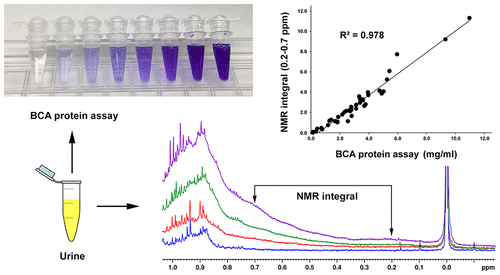当前位置:
X-MOL 学术
›
Anal. Chem.
›
论文详情
Our official English website, www.x-mol.net, welcomes your
feedback! (Note: you will need to create a separate account there.)
1H Nuclear Magnetic Resonance Spectroscopy-Based Methods for the Quantification of Proteins in Urine
Analytical Chemistry ( IF 6.7 ) Pub Date : 2021-09-21 , DOI: 10.1021/acs.analchem.1c01618 Ivan Vuckovic 1 , Aleksandar Denic 2 , M Cristine Charlesworth 3 , Milovan Šuvakov 4 , Shane Bobart 2 , John C Lieske 2 , Fernando C Fervenza 2 , Slobodan Macura 1, 5
Analytical Chemistry ( IF 6.7 ) Pub Date : 2021-09-21 , DOI: 10.1021/acs.analchem.1c01618 Ivan Vuckovic 1 , Aleksandar Denic 2 , M Cristine Charlesworth 3 , Milovan Šuvakov 4 , Shane Bobart 2 , John C Lieske 2 , Fernando C Fervenza 2 , Slobodan Macura 1, 5
Affiliation

|
We described several postprocessing methods to measure protein concentrations in human urine from existing 1H nuclear magnetic resonance (NMR) metabolomic spectra: (1) direct spectral integration, (2) integration of NCD spectra (NCD = 1D NOESY-CPMG), (3) integration of SMolESY-filtered 1D NOESY spectra (SMolESY = Small Molecule Enhancement SpectroscopY), (4) matching protein patterns, and (5) TSP line integral and TSP linewidth. Postprocessing consists of (a) removal of the metabolite signals (demetabolization) and (b) extraction of the protein integral from the demetabolized spectra. For demetabolization, we tested subtraction of the spin-echo 1D spectrum (CPMG) from the regular 1D spectrum and low-pass filtering of 1D NOESY by its derivatives (c-SMolESY). Because of imperfections in the demetabolization, in addition to direct integration, we extracted protein integrals by the piecewise comparison of demetabolized spectra with the reference spectrum of albumin. We analyzed 42 urine samples with protein content known from the bicinchoninic acid (BCA) assay. We found excellent correlation between the BCA assay and the demetabolized NMR integrals. We have provided conversion factors for calculating protein concentrations in mg/mL from spectral integrals in mM. Additionally, we found the trimethylsilyl propionate (TSP, NMR standard) spectral linewidth and the TSP integral to be good indicators of protein concentration. The described methods increase the information content of urine NMR metabolomics spectra by informing clinical studies of protein concentration.
中文翻译:

基于 1H 核磁共振光谱的尿液蛋白质定量方法
我们描述了几种后处理方法来测量人类尿液中蛋白质浓度的现有1H 核磁共振 (NMR) 代谢组学谱:(1) 直接谱积分,(2) NCD 谱积分 (NCD = 1D NOESY-CPMG),(3) SMolESY 过滤的 1D NOESY 谱积分(SMolESY = 小分子增强) SpectroscopY)、(4) 匹配蛋白质模式和 (5) TSP 线积分和 TSP 线宽。后处理包括 (a) 去除代谢物信号 (解代谢) 和 (b) 从解代谢光谱中提取蛋白质积分。对于代谢,我们测试了从常规一维光谱中减去自旋回波一维光谱 (CPMG) 并通过其衍生物 (c-SMolESY) 对一维 NOESY 进行低通滤波。由于代谢不完善,除了直接整合,我们通过分解代谢光谱与白蛋白参考光谱的分段比较来提取蛋白质积分。我们分析了 42 份尿液样本,其蛋白质含量从二辛可宁酸 (BCA) 测定中得知。我们发现 BCA 分析与去代谢的 NMR 积分之间存在极好的相关性。我们提供了用于从以 mM 为单位的光谱积分计算以 mg/mL 为单位的蛋白质浓度的转换因子。此外,我们发现丙酸三甲基甲硅烷基酯(TSP,NMR 标准)光谱线宽和 TSP 积分是蛋白质浓度的良好指标。所描述的方法通过为蛋白质浓度的临床研究提供信息来增加尿液 NMR 代谢组学光谱的信息含量。我们发现 BCA 分析与去代谢的 NMR 积分之间存在极好的相关性。我们提供了用于从以 mM 为单位的光谱积分计算以 mg/mL 为单位的蛋白质浓度的转换因子。此外,我们发现丙酸三甲基甲硅烷基酯(TSP,NMR 标准)光谱线宽和 TSP 积分是蛋白质浓度的良好指标。所描述的方法通过为蛋白质浓度的临床研究提供信息来增加尿液 NMR 代谢组学光谱的信息含量。我们发现 BCA 分析与去代谢的 NMR 积分之间存在极好的相关性。我们提供了用于从以 mM 为单位的光谱积分计算以 mg/mL 为单位的蛋白质浓度的转换因子。此外,我们发现丙酸三甲基甲硅烷基酯(TSP,NMR 标准)光谱线宽和 TSP 积分是蛋白质浓度的良好指标。所描述的方法通过为蛋白质浓度的临床研究提供信息来增加尿液 NMR 代谢组学光谱的信息含量。
更新日期:2021-10-06
中文翻译:

基于 1H 核磁共振光谱的尿液蛋白质定量方法
我们描述了几种后处理方法来测量人类尿液中蛋白质浓度的现有1H 核磁共振 (NMR) 代谢组学谱:(1) 直接谱积分,(2) NCD 谱积分 (NCD = 1D NOESY-CPMG),(3) SMolESY 过滤的 1D NOESY 谱积分(SMolESY = 小分子增强) SpectroscopY)、(4) 匹配蛋白质模式和 (5) TSP 线积分和 TSP 线宽。后处理包括 (a) 去除代谢物信号 (解代谢) 和 (b) 从解代谢光谱中提取蛋白质积分。对于代谢,我们测试了从常规一维光谱中减去自旋回波一维光谱 (CPMG) 并通过其衍生物 (c-SMolESY) 对一维 NOESY 进行低通滤波。由于代谢不完善,除了直接整合,我们通过分解代谢光谱与白蛋白参考光谱的分段比较来提取蛋白质积分。我们分析了 42 份尿液样本,其蛋白质含量从二辛可宁酸 (BCA) 测定中得知。我们发现 BCA 分析与去代谢的 NMR 积分之间存在极好的相关性。我们提供了用于从以 mM 为单位的光谱积分计算以 mg/mL 为单位的蛋白质浓度的转换因子。此外,我们发现丙酸三甲基甲硅烷基酯(TSP,NMR 标准)光谱线宽和 TSP 积分是蛋白质浓度的良好指标。所描述的方法通过为蛋白质浓度的临床研究提供信息来增加尿液 NMR 代谢组学光谱的信息含量。我们发现 BCA 分析与去代谢的 NMR 积分之间存在极好的相关性。我们提供了用于从以 mM 为单位的光谱积分计算以 mg/mL 为单位的蛋白质浓度的转换因子。此外,我们发现丙酸三甲基甲硅烷基酯(TSP,NMR 标准)光谱线宽和 TSP 积分是蛋白质浓度的良好指标。所描述的方法通过为蛋白质浓度的临床研究提供信息来增加尿液 NMR 代谢组学光谱的信息含量。我们发现 BCA 分析与去代谢的 NMR 积分之间存在极好的相关性。我们提供了用于从以 mM 为单位的光谱积分计算以 mg/mL 为单位的蛋白质浓度的转换因子。此外,我们发现丙酸三甲基甲硅烷基酯(TSP,NMR 标准)光谱线宽和 TSP 积分是蛋白质浓度的良好指标。所描述的方法通过为蛋白质浓度的临床研究提供信息来增加尿液 NMR 代谢组学光谱的信息含量。











































 京公网安备 11010802027423号
京公网安备 11010802027423号